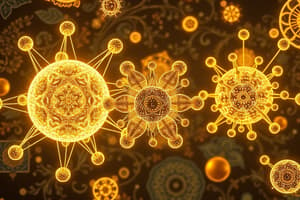Podcast
Questions and Answers
What type of atoms have a full outer electron shell and are stable?
What type of atoms have a full outer electron shell and are stable?
- Alkali metals
- Transition metals
- Halogens
- Noble gases (correct)
Which term refers to charged atoms or groups of atoms that have gained or lost electrons?
Which term refers to charged atoms or groups of atoms that have gained or lost electrons?
- Molecules
- Isotopes
- Compounds
- Ions (correct)
What is the term used for ions with an extra electron?
What is the term used for ions with an extra electron?
- Anions (correct)
- Oxides
- Cations
- Halides
Which chemical bond is formed when atoms transfer electrons to achieve a stable electron configuration?
Which chemical bond is formed when atoms transfer electrons to achieve a stable electron configuration?
In the formation of sodium chloride (NaCl), which atom becomes a positively charged ion?
In the formation of sodium chloride (NaCl), which atom becomes a positively charged ion?
What determines the atomic number of an atom?
What determines the atomic number of an atom?
In the formation of covalent bonds, what do atoms share?
In the formation of covalent bonds, what do atoms share?
Which type of bond involves the transfer of electrons between atoms?
Which type of bond involves the transfer of electrons between atoms?
What does valency represent in an element?
What does valency represent in an element?
Why do atoms with less than a full outer electron shell seek to gain or share electrons?
Why do atoms with less than a full outer electron shell seek to gain or share electrons?
Flashcards are hidden until you start studying
Study Notes
Understanding Atoms and Molecules: Valency and Ions
At the core of our physical world lie two fundamental building blocks: atoms and molecules. As we delve into these structures, we encounter the concepts of valency and ions, which help us comprehend the behaviors and interactions of these building blocks. Let's embark on a journey to explore these vital ideas and their influence on the world around us.
Atoms
Atoms, the smallest units of matter, are made up of protons, neutrons, and electrons. Protons are positively charged, neutrons are electrically neutral, and electrons are negatively charged. The number of protons in an atom determines its atomic number, which uniquely identifies each element.
Molecules
Molecules are composed of atoms bonded together. The forces that bind atoms into molecules are known as chemical bonds. These chemical bonds are primarily of two types: covalent bonds and ionic bonds. Covalent bonds occur when atoms share electrons, while ionic bonds occur when electrons are transferred between atoms, resulting in charged ions.
Valency
Valency, also known as the combining capacity of an element, represents the number of electrons an atom can gain, lose, or share to achieve a stable electron configuration. This concept is a critical factor in determining the type of chemical bond that forms between atoms.
Atoms with less than a full outer electron shell seek to achieve a stable electron configuration by either gaining or sharing electrons. Atoms with a full outer electron shell, such as noble gases, are stable and do not seek to form chemical bonds.
Ions
Ions are charged atoms or groups of atoms that have gained or lost electrons to achieve a stable electron configuration. Ions with an extra electron are called anions, and ions with one or more electrons fewer than the number of protons are called cations.
Ionic bonds form between atoms when they transfer electrons to achieve a stable electron configuration. Anions and cations are attracted to each other due to the electrostatic forces between their opposite charges.
Valency and Ions in Action
To understand the importance of valency and ions, consider the formation of sodium chloride (NaCl). Sodium (Na) has one less electron than the stable electron configuration, while chlorine (Cl) needs one more electron. When a sodium atom loses one electron, it becomes a positively charged ion (Na+), and when a chlorine atom gains one electron, it becomes a negatively charged ion (Cl–). The electrostatic attraction between the oppositely charged ions results in the formation of an ionic bond, which in turn creates a crystalline lattice structure of sodium chloride.
Conclusion
In summary, understanding valency and ions provides insight into the behaviors and interactions of atoms and molecules. The stability of atoms and molecules is directly related to their electron configurations, and the transfer of electrons between atoms results in the formation of ionic bonds.
As we continue to explore the world around us, the concepts of valency and ions serve as foundational tools for understanding and interpreting the complex interactions between atoms and molecules. These ideas lead us to a deeper appreciation for the fundamental building blocks of our universe and the forces that bind them together.
Studying That Suits You
Use AI to generate personalized quizzes and flashcards to suit your learning preferences.




